Recent Water Damage Posts
5 Essential Tips to Minimize Flood Risks in Your Colorado Springs Home
5/18/2024 (Permalink)
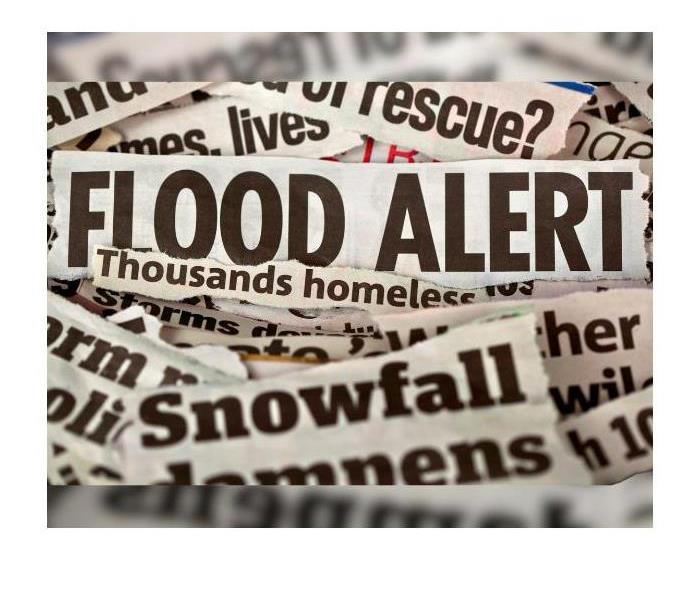 Minimize Flood Risks in Colorado Springs.
Minimize Flood Risks in Colorado Springs.
Living in Colorado Springs offers an idyllic blend of mountainous landscapes and urban amenities. However, the region's geography, characterized by its proximity to the Rocky Mountains, also brings the risk of flooding, particularly during the spring and summer months when snowmelt and heavy rains are common. To safeguard your home and loved ones from potential flood damage, here are five essential tips to reduce flood risks in your Colorado Springs residence.
1. Understand Your Property's Flood Risk:
Before implementing any flood mitigation measures, it's crucial to understand the specific flood risk your property faces. Colorado Springs residents can utilize FEMA's Flood Map Service Center or consult local authorities to determine whether their property lies within a floodplain or high-risk zone. Identifying the flood risk level enables homeowners to tailor their mitigation strategies accordingly. Even properties outside designated flood zones can still be susceptible to localized flooding, so it's essential to assess drainage patterns, nearby water bodies, and historical flood data.
2. Invest in Flood Insurance:
While standard homeowners' insurance policies typically don't cover flood damage, purchasing flood insurance through the National Flood Insurance Program (NFIP) can provide invaluable financial protection. Given Colorado Springs' vulnerability to flash floods and heavy precipitation, securing flood insurance is a proactive step towards mitigating the financial impact of flood-related losses. It's important to note that there is typically a 30-day waiting period before flood insurance policies take effect, so don't wait until the last minute to secure coverage.
3. Implement Property-Level Flood Mitigation Measures:
Retrofitting your home with flood-resistant features can significantly reduce the risk of damage during flooding events. Start by elevating utilities such as HVAC systems, electrical panels, and water heaters above potential flood levels. Consider installing flood vents in your foundation to equalize hydrostatic pressure and minimize structural damage. Additionally, seal basement walls with waterproof coatings and install sump pumps to mitigate groundwater intrusion. Landscaping modifications, such as grading away from the foundation and installing rain gardens or French drains, can help redirect surface water away from your home.
4. Maintain Drainage Systems and Gutters:
Proper maintenance of drainage systems and gutters is essential for preventing water from pooling around your property and infiltrating your home. Clear debris, leaves, and sediment from gutters and downspouts regularly to ensure unobstructed water flow. Extend downspouts away from the foundation to direct rainwater at least five feet away from your home's perimeter. Check and clean storm drains, culverts, and ditches on your property to prevent blockages that could exacerbate flooding during heavy rainfall. Consider installing gutter guards to minimize debris buildup and streamline maintenance efforts.
5. Stay Informed and Prepared:
Knowledge is key to effectively managing flood risks. Stay informed about weather forecasts, flood warnings, and emergency evacuation procedures provided by local authorities. Sign up for emergency alerts and consider investing in a NOAA Weather Radio for real-time updates during severe weather events. Develop a comprehensive emergency preparedness plan for your household, including evacuation routes, communication protocols, and emergency supply kits. Keep important documents, such as insurance policies and personal identification, in a waterproof and easily accessible container. Conduct regular drills to ensure everyone in your household knows what to do in the event of a flood.
In conclusion, reducing flood risks in your Colorado Springs home requires a proactive and multi-faceted approach. By understanding your property's flood risk, investing in flood insurance, implementing property-level mitigation measures, maintaining drainage systems, and staying informed and prepared, you can minimize the potential impact of flooding on your home and family. While it's impossible to eliminate all flood risks entirely, taking these steps can significantly enhance your resilience and peace of mind in the face of nature's unpredictability.
How We Can Rescue Your Home from Water Damage
1/12/2024 (Permalink)
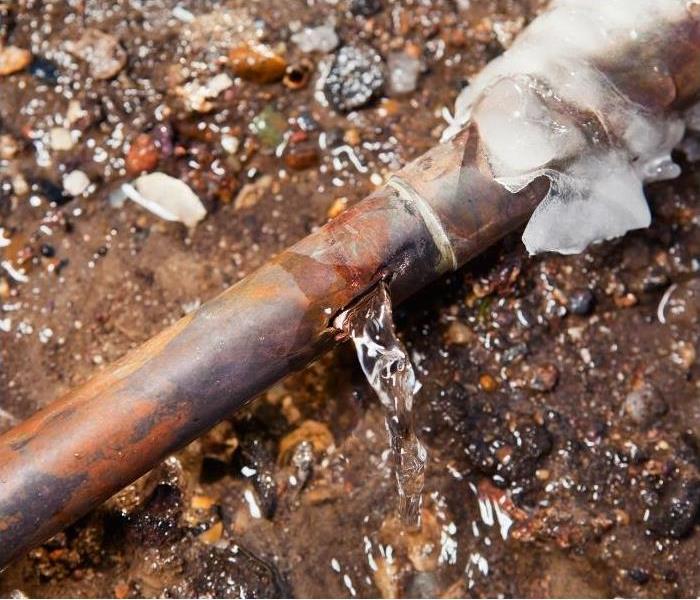 Water Damage in Black Forest, East Colorado Springs, CO.
Water Damage in Black Forest, East Colorado Springs, CO.
Water damage is a homeowner's worst nightmare, striking unexpectedly and leaving a trail of destruction in its wake. One common culprit is a leaking pipe, a seemingly innocent issue that can quickly escalate into a major disaster. When it comes to salvaging your home and possessions from the clutches of water damage, we emerge as a beacon of hope. In this blog, we'll explore the nuances of water damage caused by a leaking pipe in a residential home and delve into how SERVPRO's expertise and services can be your lifeline in such dire situations.
Understanding the Impact of a Leaking Pipe
A leaking pipe may start as a minor inconvenience, but its consequences can be far-reaching and devastating. Water seeping into walls, ceilings, and floors can lead to structural damage, mold growth, and the deterioration of personal belongings. Left unaddressed, even a small leak can spiral into a full-blown crisis, requiring extensive repairs and restoration.
The immediate impact of water damage includes structural weakening, compromised electrical systems, and the potential for hazardous mold growth. Additionally, personal belongings such as furniture, electronics, and sentimental items can be irreversibly damaged, adding emotional distress to the already challenging situation.
Recognizing the Signs
Early detection of a leaking pipe is crucial in mitigating the extent of water damage. Homeowners should be vigilant and look out for signs such as:
Water Stains: Discoloration on walls or ceilings could indicate water seepage from an unseen source.
Musty Odors: A persistent musty smell might signal hidden mold growth resulting from water damage.
Decreased Water Pressure: A sudden drop in water pressure may indicate a leak in the plumbing system.
Unexplained Sounds: Dripping or rushing water sounds in walls or ceilings could point to a concealed leak.
Our Role in Water Damage Restoration
We are a renowned leader in the restoration industry, and specialize in water damage mitigation and restoration. Their comprehensive approach involves a series of steps designed to address the unique challenges posed by a leaking pipe in a residential setting.
Rapid Response: Time is of the essence when dealing with water damage. We understands the urgency and provides a rapid response to assess the situation and formulate an action plan promptly.
Assessment and Documentation: Trained professionals conduct a thorough assessment of the water damage, documenting affected areas, and creating a comprehensive plan for restoration.
Water Removal: Using advanced equipment such as industrial-strength pumps and vacuums, we efficiently remove standing water from the affected areas, preventing further damage.
Drying and Dehumidification: We employ industrial-grade dehumidifiers and drying equipment to extract moisture from surfaces and the air, ensuring a dry environment that inhibits mold growth.
Cleaning and Sanitizing: Our team meticulously cleans and sanitizes affected areas, using specialized products to prevent the growth of mold and other contaminants.
Restoration and Reconstruction: We go beyond mere cleanup; they offer comprehensive restoration services, including repairing structural damage and reconstructing affected areas to their pre-damage condition.
Benefits of Choosing Us
Expertise and Experience: With decades of experience in the restoration industry, SERVPRO's technicians are highly trained and certified to handle water damage of any scale.
Advanced Technology: we invest in state-of-the-art equipment and technology, ensuring the most efficient and effective restoration processes.
Insurance Assistance: Dealing with insurance claims can be overwhelming. We work closely with insurance providers, assisting homeowners in navigating the claims process and maximizing coverage.
24/7 Availability: Water damage doesn't adhere to a schedule, and neither do we. Their emergency services are available 24/7, ensuring a swift response to minimize damage.
Commitment to Customer Satisfaction: We are committed to customer satisfaction, prioritizing open communication and transparency throughout the restoration process.
A leaking pipe may cast a shadow of despair over your home, but with us by your side, there's a silver lining. Their expertise, advanced technology, and commitment to excellence make them a beacon of hope in the face of water damage. When the rapids of a leaking pipe threaten to overwhelm your residential haven, we stand ready to navigate the tumultuous waters and guide you safely to the shores of restoration and recovery.
Is Your Water Heater Making Strange Noises?
8/31/2023 (Permalink)
 Make regular maintenance on your water heater to avoid damage in your Black Forest, CO, home.
Make regular maintenance on your water heater to avoid damage in your Black Forest, CO, home.
Water heater noises are not unheard of, but they can definitely be not only annoying but also worrisome. Is the noise indicative of a problem with the appliance, or is it just getting older? You should hire professionals to regularly maintain your Black Forest, CO, home's appliances to keep them running at their best. However, there's a good chance at some point in your water heater's life you'll hear it making sounds.
What Is Causing All the Noise?
- The Top Heating Element Is Loose
The top heating element on your electric heater could make a humming noise. When cold water flows into the tank, it can cause the heating element to vibrate, which causes humming. This issue can usually be solved simply by tightening the heating element.
- Sediment and Minerals Have Accumulated
Mineral deposits and sediment can begin building up in the heater's tank, gradually accumulating over time. The mineral deposits tend to coat the tank's interior while the sediment will settle at the bottom. Mineral buildup is more of an issue in locations with hard water. When the water heats, the minerals traveling within the water will separate and stick to the inside of the tank (i.e., limescale buildup). As the water heats up, steam builds up underneath sediment. The bubbles can make a loud popping noise. A water heater flush should be performed occasionally as part of the maintenance process so that this buildup doesn't get out of control. A rumbling sound can happen due to similar circumstances, indicating that the sediment buildup has become significant.
- Water Pressure Is Fluctuating
If you hear a ticking sound, your plumbing could be experiencing pressure fluctuations. It could be coming from one of the water inlet or outlet nipples if they have a heat trap. These types of nipples improve the energy efficiency of a water heater but can cause noises at times.
- Water Flow Is Being Blocked
Do you hear your unit making noise when you run the hot water? If you hear a sizzling noise, it could mean that water flow is being restricted.
- The Water Source Is Causing Issues
Maybe you hear a popping sound coming from the water heater. In this case, it could be the anode rod if it's made of aluminum. Aluminum can react with a high pH level, causing aluminum hydroxide to form a gel-like material in the tank. If this happens, you'll need to flush the tank and replace the anode rod with one made of magnesium that won't create a reaction.
- Condensation and Leaks Are Occurring
If you hear a sound like running water coming from the unit, you may have a pipe leak. You could also get a sizzling sound from the appliance if you have a gas heater with a condensation problem. If you don't catch this issue right away, you may not only need a plumber but also a water damage restoration professional.
Water heater problems can be annoying and possibly even damaging to the unit and your home. Anytime you hear strange noises, be on the safe side and have someone inspect your heater and plumbing.
3 Ways SERVPRO Is Faster To Any Size Disaster
9/15/2022 (Permalink)
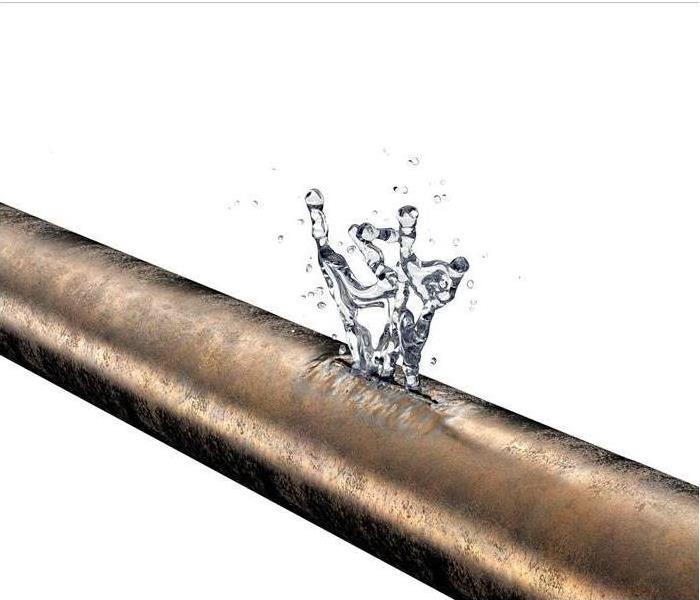 Faster To Any Size Disaster
Faster To Any Size Disaster
As one of the leaders in the restoration industry, SERVPRO prides itself on making damage from storms, water, fire and mold “Like it never even happened." SERVPRO's more than 1,700 nationwide franchises are Faster To Any Size Disaster for a variety of reasons.
SERVPRO is Faster To Any Size Disaster
- Highly Trained Professionals
Each of SERVPRO's 1,700 franchise locations is staffed by highly trained restoration specialists. This has helped make the franchise a trusted leader in the industry and a preferred vendor for many local and national insurance companies. SERVPRO knows how to get an insurance claim processed quickly and effectively.
- Residential and Commercial Services
Whether your client is a homeowner or a business owner, SERVPRO has the skills and training to be Faster To Any Size Disaster. Franchises provide emergency flood damage restoration, total home cleaning, mold remediation, fire damage restoration, storm damage restoration and cleaning services to residents in Colorado Springs, CO.
Additionally, SERVPRO professionals work hard to restore the appearance and function of commercial properties to make it “Like it never even happened.” Franchise professionals have the expertise and training to handle both large and small commercial restorations and there is always a location nearby to help with commercial fire or water damage restoration, commercial mold remediation, commercial cleaning services and commercial storm and disaster recovery.
- Always Available
SERVPRO franchise professionals are available 24 hours a day and seven days a week. Whether a disaster happens in the middle of the workweek or the middle of the night on a Sunday, SERVPRO is Here to Help. Franchise professionals know that insurance adjusters are busy and clients want to get back to their normal lives as fast as possible.
The team at SERVPRO knows how to leverage the network of SERVPRO franchises to get results for customers fast. You can count on SERVPRO to be Faster To Any Size Disaster whether you are dealing with a major storm, a small fire or anything in between.
How To Safely Clean Up Water Damage
9/15/2022 (Permalink)
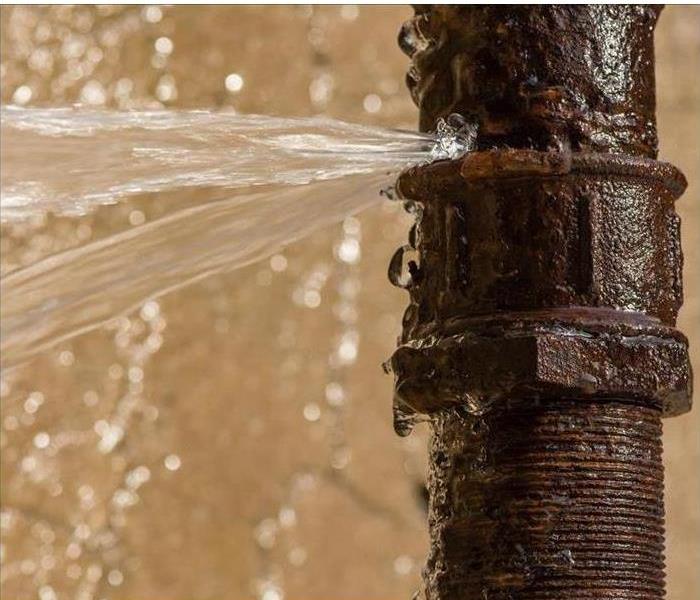 Damage from a broken pipe can be troublesome.
Damage from a broken pipe can be troublesome.
A broken pipe has created quite the mess in your home. Everything is wet, items are ruined, and you're faced with cleaning up the mess. While you wait for a water restoration company in Colorado Springs, CO, it's tempting to get inside and tackle the chaos. Be careful though. Water damage can have hazards, and it's best to remain safe. Here are a few tips to keep in mind as you clean up the property.
3 Tips To Clean Up Water Damage
1. Survey Electrical Damage
Before working in the room, look around for electrical threats. Check for water in home appliances and outlet areas. If this has occurred, then wait for the professionals. You should also head to the electrical box and turn off the circuit breakers to the impacted areas. Do not use televisions, fans, or vacuums. Think safety first.
2. Remove and Protect
When the broken pipe burst, it released an overwhelming amount of water, drenching floors and walls and ruining personal items. Save what you can by removing the damp belongings, particularly those with coloring. Allow these to dry on a porch or in a garage, any place that minimizes additional discoloration. Furthermore, remove any toys or objects that could help create space and make it easier for the repair crew.
3. Clean up the Water
When picking up after flooding, you need to prioritize drying out the room. One thing you can do is turn the air conditioning down to combat moisture. In addition, you'll want to locate a mop (not a vacuum) and begin wiping up the floor. Grab towels and wipe down the furniture. In fact, place aluminum foil underneath chair and sofa legs to create a barrier between the wet ground the furniture.
Damage from a broken pipe can be troublesome. If you want to begin to clean up, take precautions. Turn off the electricity. Then, salvage items by removing them to another room. Ultimately, you'll want to dry the room out as best as possible.
4 Things To Know About Water Damage
8/17/2022 (Permalink)
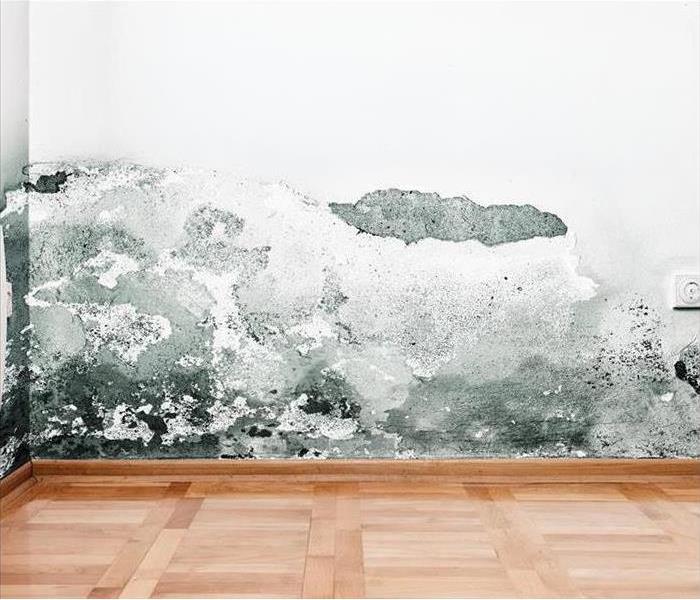 Mold growth due to untreated water damage.
Mold growth due to untreated water damage.
Out of the disasters that people worry about when it comes to their homes, water is among the top. A pipe burst or leak can create thousands of dollars in damage, requiring the expertise of a water mitigation company in Black Forest, CO. For the average homeowner, there are several things you may not understand about water damage, but there are at least four things you should.
4 Facts About Water Damage
1. It's Compounding
Water damage does not occur in its own little bubble. The damage quickly spreads and evolves. For example, a small leak in a water line may seem minor, but if left untreated for too long, it can lead to mold growth and other issues. When faced with a water emergency, time is of the essence.
2. It's Expensive
While most water problems can be mitigated early before the costs swell, many issues occur behind walls, which means that by the time a homeowner is aware of the issue, significant damage has occurred. The best way to prevent hidden problems is to have an annual or semiannual assessment of your home's plumbing.
3. It's Salvageable
While a pipe burst can seem beyond repair because of the level of harm to your house, it is not. There are dedicated mitigation companies for water damage repair. While the damage may be extensive, most of the time, it is repairable.
4. It's Avoidable
The most common misconception of water problems is that they are unavoidable. Most water crises are avoidable with proper prevention measures. For example, many people fall victim to flooding every year, but with the installation of a sump pump or backwater valves, you can limit your risks, if not eliminate them.
Are you ready for water damage? Do you know how to avoid it? Contact a local water mitigation service to discuss prevention methods and to ensure that you are informed about all water damage possibilities, even a pipe burst. Do not let your home fall victim to preventative issues.
How To Clean Up Contaminated Water
6/17/2022 (Permalink)
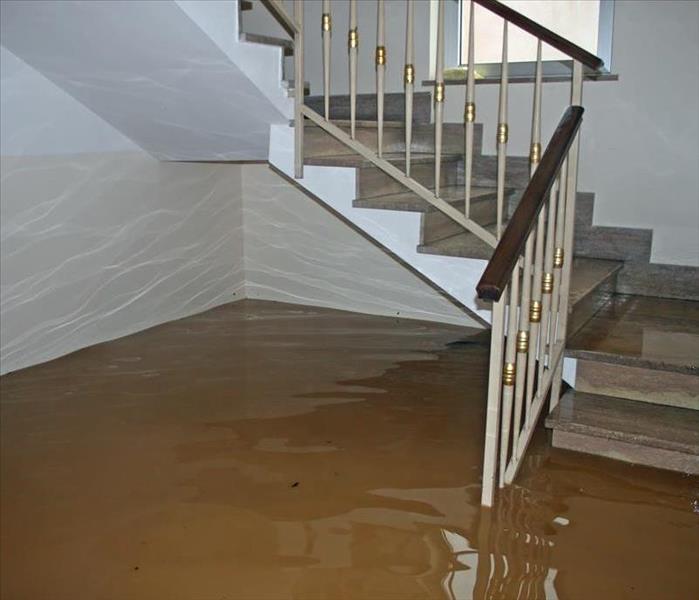 Let Contaminated Water be cleaned by specialists.
Let Contaminated Water be cleaned by specialists.
Water in your home can cause significant property damage. It can also be more complicated to clean up than simply grabbing a mop and bucket due to the risk of dealing with contaminated water.
Contaminated Water Cleanup
Before you attempt to clean up water damage in your home, it is important to identify which of the three types of water damage you have.
1. Clean Water
Clean water is water damage caused by a leak from a sanitary water source. Examples include water from a broken supply line, rainwater and water that overflowed from a clean sink, toilet tank or bathtub. This type of water contains minimal contamination.
2. Grey Water
Grey water is wastewater that contains some contamination but is not grossly unsanitary. Grey water may contain bacteria, mold, viruses, chemicals or nutrients that promote the growth of microorganisms.
Examples include wastewater from your washing machine, water from a broken aquarium and overflow from a toilet that contains urine but no feces.
3. Black Water
This water is grossly contaminated. It may contain pathogens or toxins that pose a risk to human health. Examples include floodwater, seawater, sewage, wind-driven rain and an overflow from a toilet that contains feces.
Cleaning Different Types of Water Damage
If there is a small amount of clean water in your home, you can clean it yourself with a mop and bucket, sponges or a wet/dry vacuum. Surfaces that have come in contact with grey water must be disinfected.
Additionally, because contaminants in the water may irritate the skin or pose other risks, protective gear, such as rubber gloves, should be worn while cleaning grey water damage. Black water can not be safely cleaned without the proper protective equipment and safety training. Homeowners should not attempt to clean this type of damage.
Reasons To Clean Water Damage Promptly
If you have a significant amount of any type of water or you have damage from grey or black water, consider contacting a water restoration service in Black Forest, CO, to clean and disinfect your property. Water damage should be cleaned within 24-48 hours whenever possible.
Water that has been left standing longer than this may become contaminated with mold and other microorganisms. The moisture can also promote mold and mildew growth in your home. Once past the 24-48 hour window, clean water may become grey or black.
What To Do With Water Damaged Property
Property that has come in contact with contamination must be disinfected before it can be safely used again. Some types of porous materials, such as insulation, drywall and carpet padding, may need to be thrown out. Additionally, discard any food items that have been exposed to contamination unless the food is stored in an undamaged waterproof container.
Food or drink in waterproof cans or pouches can be used if you remove the labels, wash the containers in soap and water, rinse them with clean water and then sanitize them with boiling water or diluted bleach.
Contaminated water can be difficult to clean without the proper equipment and training. Many homeowners can benefit from professional cleaning assistance when dealing with water damage.
Understanding Homeowners Insurance Coverage for Flood Damage
4/9/2022 (Permalink)
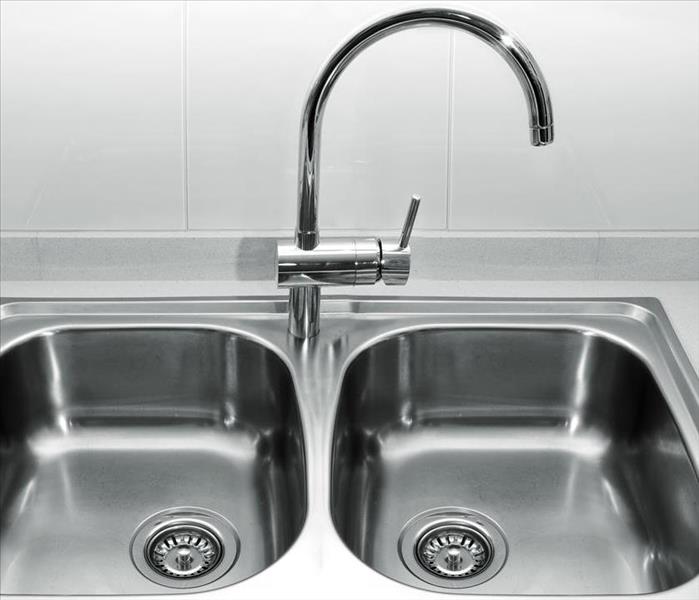 Learn more about Insurance Coverage for Flood Damage by Following these Tips.
Learn more about Insurance Coverage for Flood Damage by Following these Tips.
If your home is financed through a mortgage, then you’re required to carry a homeowners insurance policy by your lender. This insurance plan protects the lender’s interest in your property. Even if you don’t have a mortgage, having property insurance is a wise move for your home in Colorado Springs, CO.
If your house is subject to certain types of damage, a policy spares you from having to pay out of pocket for repairs or replacement. Carrying property coverage is part of being a responsible owner, but you also should know what is and isn’t covered. Flood damage, for instance, is generally not covered. Let’s take a closer look at water damage and homeowner coverage.
A Closer Look at Flooding and Insurance Coverage
Your homeowners policy does not cover damage from the following types of flooding:
- Storms and weather events
- Overflow from bodies of water such as lakes, rivers, and ponds
- Oversaturated ground
You would need to purchase a separate flood insurance policy for protection from flood damage. There are other types of water damage that you may experience in your home, some of which is not included in your coverage.
What’s Covered and What’s Not
Water damage in your home may also arise from a broken pipe, an overflowing toilet, or a malfunctioning appliance such as a dishwasher or washing machine. When it comes to your policy, coverage isn’t based on the extent of damage, but rather on whether the problem was immediate or gradual. Most insurance plans will only cover damage that is sudden and accidental.
Destruction that comes from a gradual problem probably won’t be covered by your plan. This is one reason why regular inspection of your house and its mechanical, electrical, plumbing, and HVAC systems are characteristic of responsible homeownership.
Other Exclusions
It’s important to understand the limitations and restrictions of your policy. We’ve established that sudden water damage is usually protected, but be aware of the following exclusions:
Poor maintenance: A broken pipe from a freeze seems like a no-brainer, but your claim could be denied for failure to wrap your pipes and take other preventive steps when the weather is very cold.
Source of damage: If a busted dishwasher supply line causes damage to your floors, your policy would cover floor replacement, but not the dishwasher.
Sewer or drain backup: If an outside sewer, drain, or pipeline backs up into your residence, your homeowners plan won’t cover any repairs. You might be able to purchase a separate policy to cover water backup.
When Disaster Strikes
No matter what type of water damage you experience, it’s important to contact a company that specializes in water damage repair. These professionals have the knowledge, expertise, and equipment to restore your house to pre-damage conditions. They know the best ways to expedite the process, looking for ways to lower costs by prioritizing repairs over replacement where possible.
Having homeowners’ insurance is a good idea whether you have a mortgage or not. While your policy may not cover flood damage, it can cover your costs for repair from other water problems. There’s no time like the present to become familiar with what your plan includes and excludes.
3 Questions To Ask Your FEMA Representative After a Flood
10/12/2021 (Permalink)
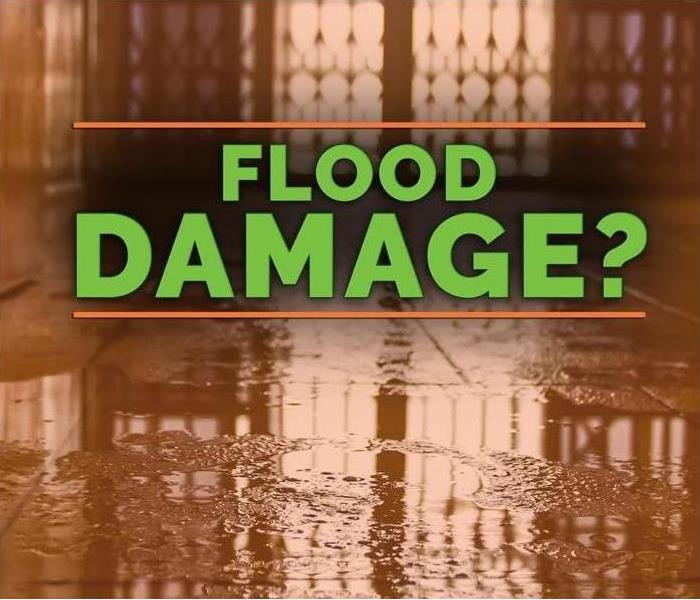 Asking the right questions can streamline this process and give you peace of mind for the future.
Asking the right questions can streamline this process and give you peace of mind for the future.
When a major flood affects your home in Colorado Springs, CO taking the first steps toward recovery can be difficult. You may have many questions, including how to qualify for assistance from the Federal Emergency Management Agency. FEMA can help you and your family recover when floodwater causes serious damage to your home, and there are several questions you can ask your representative or inspector once he or she arrives at your property, as the answers may help you gain peace of mind in the wake of a serious flood.
What To Ask At Your FEMA Representative
What Is the First Step in Qualifying for Assistance?
If your neighborhood or county has been declared a disaster area after a flood, then it is likely you will qualify for help. Use a family member or friend’s phone to access the department’s helpline or visit their website. From there, you can download forms and applications. A representative will likely contact you soon after.
How Does Homeowner’s Insurance Affect Assistance?
You may still qualify for FEMA assistance if your home is insured. However, you must first file a claim with your insurance company and then supply the Federal Emergency Management Agency with a letter that states the company’s findings. For example, if your insurance company denies any compensation because your policy does not cover flood damage, the agency will likely need a written statement before an inspector is sent to your property. If your home is covered by flooding insurance, the agency may inspect your home to determine whether you qualify for help not covered by that policy.
What if Home Repairs Have Already Been Made?
If you have made any repairs to your home or called in flood damage and restoration company to handle the job, you may qualify for reimbursement. However, it is important that you take photos of the damage and the restoration job, as well as keep careful track of any expenses you incur during the repair phase, so you have proof of what you spent.
When a serious flood causes damage to your home, FEMA can help you
How To Prevent a Flooded Construction Site
10/11/2021 (Permalink)
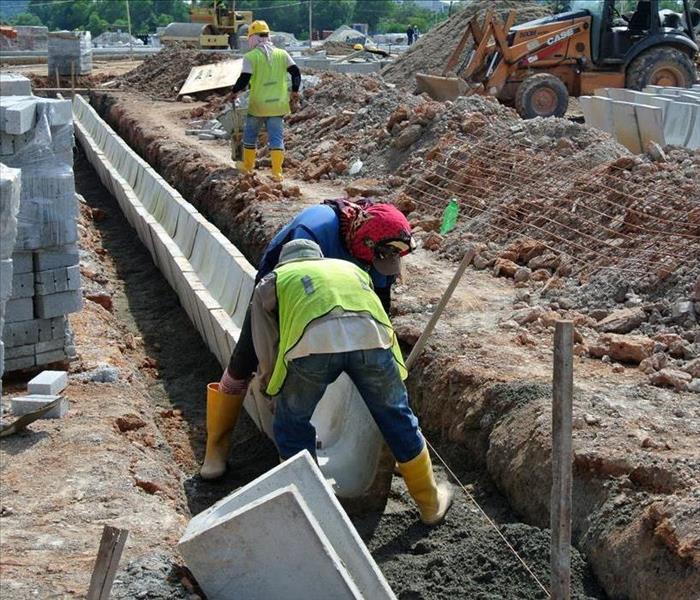 A drain will avoid water damage in your construction in Black Forest, CO.
A drain will avoid water damage in your construction in Black Forest, CO.
If you've been considering starting a construction project in Black Forest, CO, there are many aspects of the plan that you'll need to analyze. One of the most essential objectives throughout the building project is protecting the site and everything on it. Water can be one of the most damaging intrusions that a construction site can endure. It can also delay the work significantly. There are ways to prevent loss from water and ways to deal with water pipe repair and other solutions as various issues arise. This involves careful planning and continually watching for water problems. Then, they should be addressed as quickly as possible. With a solid pre-construction plan, close investigation, protection during the entire process, and thorough testing during and after construction, you can ensure your project will go as smoothly as possible.
How To Handle a Broken Pipe and Other Causes of Water Damage
1. Outdoor Drainage Problems
Water can pool around the construction site if drainage is inadequate or a water system malfunctions due to a blockage. There are various ways to avoid this problem, including creating proper drainage methods, utilizing sandbags, and grading the surrounding land.
2. Water System Failures
Construction sites have various systems that can potentially cause water damage before the project is even completed. These systems include plumbing, drainage, mechanical, and fire protection systems. When these systems malfunction or fail, they can cause significant water damage to many different parts of the construction site. To prevent these problems, make sure only authorized contractors install and maintain these systems. Also, make sure the piping is installed correctly according to the construction documents, and continually monitor the system for at least 24 hours in case an emergency water pipe repair is needed.
3. Storage of Water-Sensitive Materials
You will typically have some materials on the construction site that will be ruined if flooded. Have a waterproof area to store electronics, such as laptops and tablets, paper documents, etc. If they can't be stored in a place that's guaranteed waterproof, they should be put inside, up on pallets, and covered with plastic or tarps. If you experience damage, water damage restoration experts can help.
4. Faulty Pipe Connections or Drain Fittings
Installation issues with pipe connections and drain fittings can cause water leak problems. The main reason for this is the crimping technique that's used as opposed to soldering. Have your on-site manager inspect and sign off on the pipe system before you start the water running through it. Then, activate flow alarms to alert you of any system leaks. These leaks can cause issues with water flow.
Managing everything that happens daily at a construction site is hard work, to say the least. The last thing you need is a water disaster, in which you have to find someone to perform a quick water pipe repair or locate a quick solution to another emergency. Be proactive and remember these tips for preventing water loss at your construction site. Knowing what to do beforehand can provide you and your workers a little more peace of mind.
Questions and Answers Regarding Your Wet Crawl Space
9/24/2021 (Permalink)
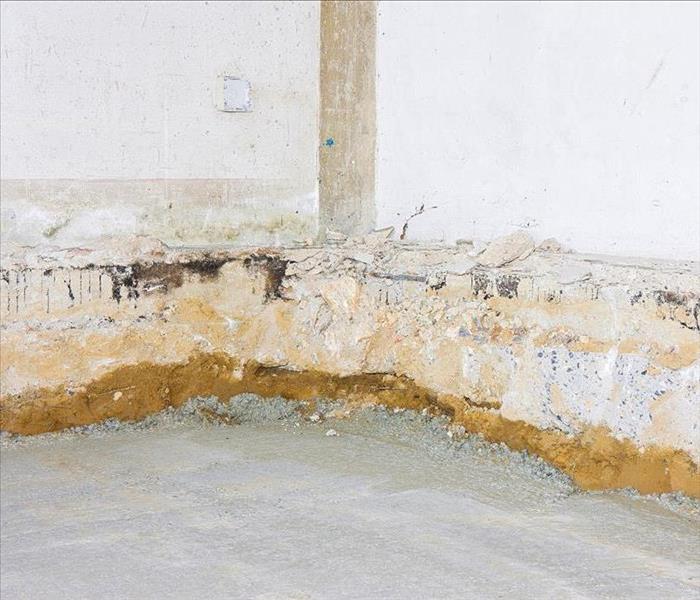 Prevent a wet crawl space by hiring a water clean-up professional in your Black Forest, CO, home.
Prevent a wet crawl space by hiring a water clean-up professional in your Black Forest, CO, home.
It's pretty common for homeowners in Black Forest, CO, to be complacent about a bit of water in the space below the home. After all, isn't a wet crawl space a normal occurrence from moisture during the seasons? However, there are some important concerns to address before turning your attention to other maintenance tasks.
What You Need To Know About Your Wet Crawl Space
Where Does the Moisture Come From?
You need to understand why the crawl space is wet. In many situations, moisture has made its way into the crawl space because of a leak in your plumbing system, water seepage from heavy rain or snow, or condensation. Water may also flow into the space from improper roof drainage or overflowing gutters. By pinpointing the source of the moisture, you may catch another proper you didn't know about, and you're ready to determine your next course of action.
Why Is Crawl Space Water a Problem?
A little bit of water from recent rainfall may not cause damage directly, but there are several ways that it can lead to trouble for you as a homeowner:
- High humidity in the crawl space causes your heating and cooling system to work harder, and this translates into higher energy costs.
- Excess moisture near the foundation of your home can increase wear and tear or lead to structural weakness through rot and rust.
- The damp, dark space under your home is an invitation to many creatures, including termites, rodents, and snakes. The unwanted pests may nibble on or burrow into the structural support of your home while also leaving behind an accumulation of droppings.
- Wet crawl space supports mold growth. These spaces are often full of organic materials, such as leaves, paper, and dead pests. As mold colonies grow, spores are released that can make their way into the rest of your home.
- When you want to sell your home, evidence of standing water or an earlier flood could discourage potential buyers, and damage caused by water could decrease the value of your home.
Although these common reasons to avoid standing water in the space under your home can cause enough trouble on their own, a combination of these concerns can lead to even more significant problems.
How Can You Prevent Water in the Crawl Space?
There are several steps you can take to prevent water from flooding into the crawl space. Most of these are preventative and some require an investment of time and resources:
- Maintain your roof and downspouts, so environmental water moves away from the foundation of your home.
- Install rain gutters and make repairs when they become damaged. Maintain them throughout the year keep them clear of debris and pests.
- Install a vapor barrier or other encapsulation system to prevent most crawl space damage and prevent moisture from entering your home.
- Talk to professionals about the best course of action for your home. They have insights into location-specific concerns and solutions.
When Should You Address the Problem?
Now is the time for you to take preventative action. Don't wait for evidence of a wet crawl space before you contact water damage cleanup and prevention professionals. Act immediately to eliminate the threat of damage.
Not All Water Damage Is the Same
8/13/2021 (Permalink)
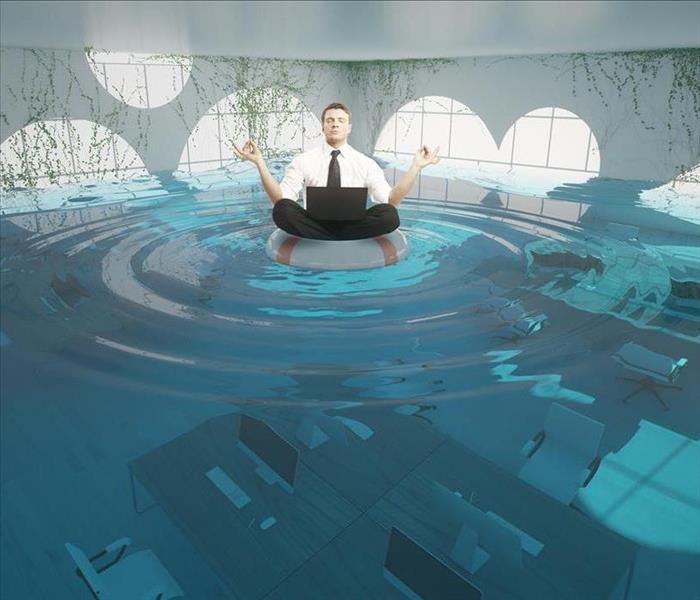 Exist three categories of water damage and it is fundamental to recognize them to know how to fix the damage.
Exist three categories of water damage and it is fundamental to recognize them to know how to fix the damage.
When your Black Forest, CO, commercial building sustains water damage, what are your options for restoration? First, before you even deal with the water pipe repair or other repairs, you must determine what kind of water you're dealing with. While any moisture can cause a lot of costly damage to a structure and its contents, some floodwaters require a very different approach than others.
There are three categories of water damage.
1. Category 1: Clean Water
Water damage isn't good no matter what variety it is, but if your building has to flood, Category 1 water is preferable. This water can come from various sources, including a broken water supply line, an appliance leak, rainwater, melting ice or snow, or an overflowing sink or bathtub that contains no contaminants. This is also known as "clean water," which means it doesn't threaten people or pets with toxins. Just as with any water intrusion, cleanup must begin swiftly, as standing water or excess moisture can cause mold growth to start within 24 hours of the occurrence.
2. Category 2: Gray Water
Category 2 water is also commonly known as "gray water." This water includes some kind of contaminant which could be chemical, biological, or physical contamination. This type of water damage results from events such as sump pump failures, leaking dishwashers or washing machines, overflowing toilets (containing only urine), fire sprinkler water, and chilled or condensate water.
Category 2 damage can also result from clean water sitting too long that turns to gray water. Additionally, it can happen as clean water travels through other materials, such as a Category 1 flood from a broken pipe on the second floor of a building as it travels through building materials. As a result, Category 2 water collects on the first floor. Gray water can make people and animals sick if they touch it due to microorganisms and other contaminants. You may feel that merely extracting the water and drying the area is enough, aside from the water pipe repair. When your building undergoes this type of damage, it's essential to make sure the affected area and its contents are thoroughly and quickly decontaminated and dried.
3. Category 3: Black Water
The worst possible type of water damage is caused by Category 3 water, which is also referred to as "black water." This water is heavily contaminated, containing sewage or floodwaters from rivers or streams. Blackwater can also occur from gray water being left to linger without proper cleanup. After your building has flooded with black water, it's vital to have flood restoration professionals use their expertise and equipment to handle the process safely, properly, and thoroughly.
Not all flood water is the same. When your building sustains water damage, whether, from a broken pipe, a sewage overflow, or heavy rainfall, you must determine if you're dealing with clean water, gray water, or black water. Even more important than making necessary repairs, such as a water pipe repair, is cleaning up correctly from the water damage. Proper cleaning and decontaminating will ensure that everyone remains safe, and it'll help return your building up to code.
Replacing a Toilet
4/20/2021 (Permalink)
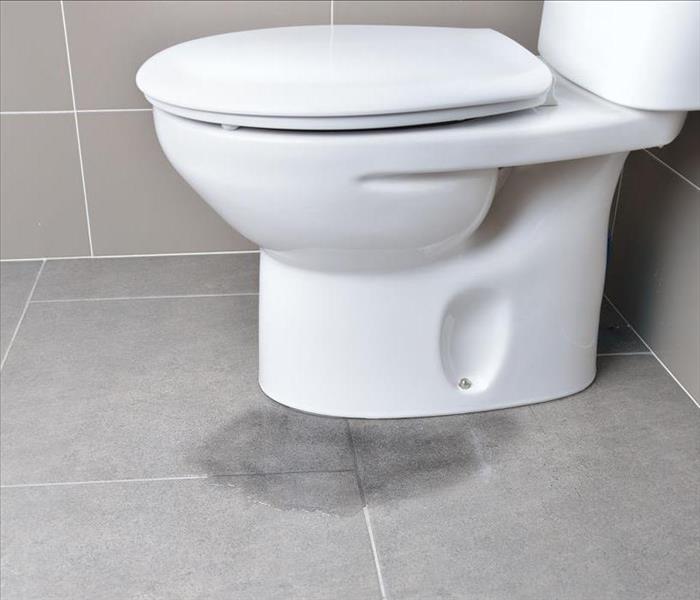 Replace a leaking toilet to avoid further damage.
Replace a leaking toilet to avoid further damage.
No homeowner wants to deal with water issues, especially when it comes to their toilet. A leaking toilet can be the result of numerous issues, but if the water is seeping out around the base of the fixture, you might have a broken seal or need a replacement. While you can call on a water mitigation company in Colorado Springs, CO, the removal and replacement of a toilet is straightforward and involves three steps.
3 Steps to Replacing a Toilet
1. Remove the Toilet
You will need to start by removing the old toilet, but before you start disconnecting elements, turn off the water supply line. The shut-off should be at the back of the tank. Turn the valve until the line is closed. You will know it is closed by flushing the toilet. If the tank does not refill, the line is off.
Next, you remove the water line going into the tank and disconnect any bolts. Some toilets are one-piece and other two. With a two-piece, the tank might remove from the base. With all bolts, lines, and nuts removed pull the toilet free and discard. You can also peel off and discard the wax ring because you should replace that with the toilet.
2. Replace the Toilet
After removing the leaking toilet, you can bring the new toilet into the bathroom. You want to replace the wax seal and then seat the toilet correctly. With the toilet in place, you can snug up all the nuts and bolts and reattach the supply line. However, do not turn the water on just yet.
3. Sealing the Base of the Toilet
Many professional installers do not like to seal around the base of the toilet with caulk because they believe it makes it more difficult to tell when something is wrong and in need of a toilet repair. Unfortunately, building codes may dictate the use of caulk. Before turning the water back on, determine the regulations for your area. If the caulk is required, use a mildew-resistant product and then turn the supply back on.
A leaking toilet does not always require professional help. However, sometimes the problem might be bigger than expected.
4 Steps To Take When Pipes Burst
3/29/2021 (Permalink)
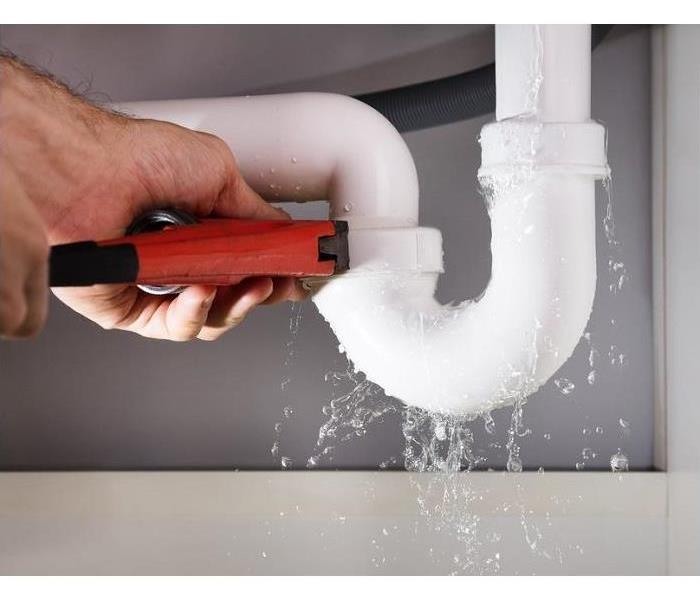 Shuf off the water supply when a pipe bursts
Shuf off the water supply when a pipe bursts
A quick response to water damage is crucial for the well-being of your Black Forest, CO, home. However, professionals usually can't arrive within seconds. In those crucial moments between the burst pipes and the arrival of water cleanup and restoration technicians, take the following steps.
Steps to Take When a Pipe Bursts
Assess the Risk to Your Family
Immediately decide whether the water comes from a clean source or a contaminated source. For example, water flowing from the pipes directly connected to the kitchen sink is probably clean. However, water containing sewage from the toilet is hazardous; your family should be evacuated from the home.
Turn Off the Power to Your Home
It takes a tiny amount of water mixed with electricity to create the risk of electrocution. It's hard to know how far the water has traveled in those first moments, but if any water has come into contact with outlets or wiring within the walls, there is a dangerous risk of harm.
Shut Off the Water Supply
With your family safe and the power turned off, you're ready to stop the flow of water from the broken pipes or overflowing toilet. If you can quickly spot the shutoff valve closest to the source of the flooding, use that to halt the supply of water. If you don't know where that valve is located, use the main shutoff. This is often found in the basement or lowest level of the home on the perimeter walls, usually on the side facing the street.
Start Removing Water
If it's safe (water is clean, power and water are off), gather your friends and family members to bail water, vacuum, mop, and dry up as much water as possible. Carry curtains, furniture, appliances, and other household belongings to a dry location. Remember that water is heavy, so avoid injuries when handling these items.
As long as the water in your home isn't contaminated, you can take steps to protect your home from serious water damage through your water cleanup efforts. Remember that a quick response is vital.



 24/7 Emergency Service
24/7 Emergency Service













